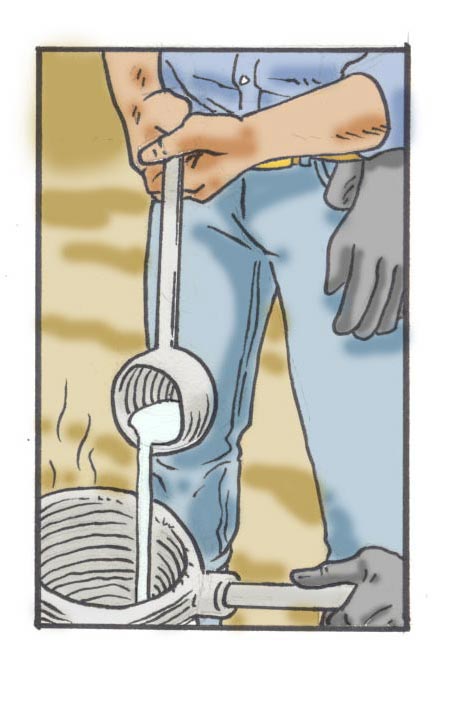
Page 4 of 5 |
|
Gerfertig opened the bucket inside the company lab himself; it was clearly mercury, but a quick pass with a Geiger counter also showed it was very "hot." He quickly stashed the ore container in a locked safe in a locked room and hadn't touched it since. That was a week ago, he noted. A day later three men were in the hospital. The man diagnosed with skin cancer had handled the ladle, the man with bone cancer closed the bucket. The man on the dozer who caught a whiff of the fumes had lung cancer. It was the dozer operator who made the sign of the cross in the changing room and went back to Mexico. Gerfertig said he began feeling nauseous two days later and his hair began to loosen in the past few days. I knew enough from my hazardous training to check the pale inside of his wrist for petechiae, the red blotches that appear when capillaries begin to hemorrhage from radiation exposure. Whatever radiation he had received wasn't enough to cause that--a positive sign. He was a slight, fair-haired man, which made him seem even more nervous when he spoke. "You can imagine how worried I am, both for myself, but also for my employees." After a thoughtful pause, he continued. "I've tried to buck up, because people know I was there and I didn't want to look sick. But I probably need to go see a doctor." "I know what accidental radiological contamination can do to somebody," Mike said. "Right now, we are all in big trouble." He was looking at me, and I took a stab at a stalling tactic. "Why don't you two keep talking and compare notes," I said, "while I hit the computer for a while." While they talked in the kitchen, I was on a computer in Gerfertig's den, doing the most frenzied googling of my life. I thought this might be a way to both calm my nerves and use my age and energy to the best advantage. It was like I was on speed as my fingers flashed over the keyboard and I kept doing searches and following links. The words and combinations zipped by: Mercury, silver, radioactive, clay, quartz, Texas, geology, dikes, on and on for five hours. I met those guys in Japan again who poured 50 lbs. of radioactive slurry in that one vat, and people I never met before, like Louis Slotin, the atomic scientist at Los Alamos who accidentally dropped one half of a atomic bomb core atop the other half in 1946 and had a criticality go off in his face. He lived for nine days. And I met the first people who talked about atoms and molecules. These philosophers and alchemists helped me ask the right questions so I could come up with a theory. By 9 p.m., any theory would do. We all knew instinctively that something would have to change by tomorrow. I walked back to the kitchen and asked Gerfertig, "The dike--it is quartz, isn't it?" "Why. Yes, mostly, it's a type of metamorphic quartz. It's an extrusion of the bedrock formation that runs through this part of Texas, this is the only place it gets close to the surface." "Do you find geodes in this area?" "Over the years, people have dug up some real nice ones. There's a shop in Pineville where they slice them up and polish them." "I assume some these geodes have been hollow?" "Yes, most are." I sat down at the table. "I have a hunch. Here's what we know." I counted off on my fingers. "One, the substance is silvery and liquid. Two, it is highly volatile and puts our fumes. Three, it is apparently highly radioactive. Four, it is naturally occurring. Five, it is self-contained." "So far, so good, those are the facts," said Mike. "But I have no idea how these all tie together." "Well, if you do a search for 'silvery' and 'liquid' and 'radioactive,' you find an interesting piece of nuclear physics. Uranium is the heaviest naturally occurring radioactive substance, but that's because the heavier elements have decayed over billions of years. Of course, some of those trans-uranium elements are still quite stable. I think the half-life of plutonium is ten thousand years." "God, you don't think we found plutonium!" Gerfertig gasped. "No, plutonium is a dark blue metal. Still, as radioactive as this stuff seems to be, it must be a trans-uranium element, and indeed, if you match up predicted characteristics based on the periodic table, you do find an element which would be a silvery liquid at room temperature. It's element 126. There is a predicted island of relative stability in the periodic table there because it would have a complete electron shell." "An element that high in the periodic table would have a ridiculously short half life," said Mike. "It would have decayed ten seconds after the big bang." "Wow, your physics is shaky," I said. "Hear me out. There's good evidence that the very heavy elements and metals are produced in the cores of stars as a result of fusion processes and shot across the galaxy by novas. It's quite possible that many trans-uranium elements were present when the earth first formed." "Present at the creation, yes, but these elements have all decayed, and so would have Element 126 by now." "True, by let's suppose that it globbed up as the primordial earth cooled, and as the magma cooled into quartz, the radioactive resonance of the element made the quartz crystallize." "I see where you're heading, but this stuff popped out of clay balls, not geodes." "What would crystalline quartz would look like after being bombarded internally by intense low-frequency radiation for four billion years?" |
|
| Back | |
